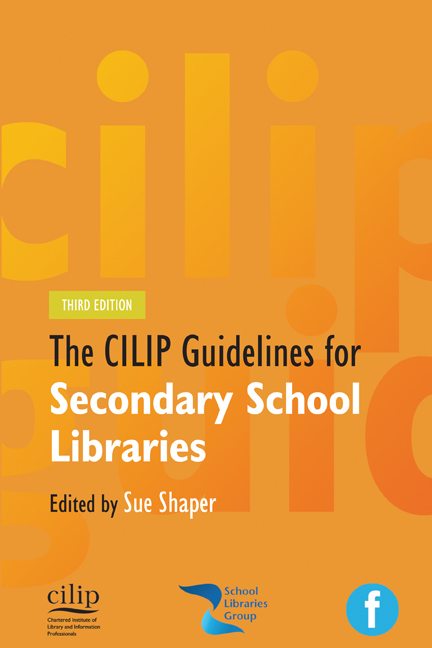Book contents
- Frontmatter
- Contents
- Foreword
- Key recommendations
- Introduction
- Notes
- Abbreviations
- 1 The school librarian and learning: CILIP's vision
- 2 Staffing and management
- 3 Policies and planning
- 4 The library environment
- 5 Management of learning resources
- 6 Information literacy
- 7 Developing students as readers
- 8 Marketing, promotion and advocacy
- 9 Evaluation
- 10 Partnerships
- References
- Appendices
- Index
- Frontmatter
- Contents
- Foreword
- Key recommendations
- Introduction
- Notes
- Abbreviations
- 1 The school librarian and learning: CILIP's vision
- 2 Staffing and management
- 3 Policies and planning
- 4 The library environment
- 5 Management of learning resources
- 6 Information literacy
- 7 Developing students as readers
- 8 Marketing, promotion and advocacy
- 9 Evaluation
- 10 Partnerships
- References
- Appendices
- Index
Summary
CILIP recommends that the librarian regularly evaluates the performance of the library. This means that:
• the librarian is fully integrated into the school's annual planning and improvement cycle
• evidence of the impact and outcomes of the librarian's work is collected
• the librarian has a vehicle for dialogue with stakeholders throughout the whole school community
• the librarian has a body of evidence underpinning his/her professional status.
Introduction
Evaluation is a key part of a school's cycle of planning and development and the evaluation of the library is an important element in that process. This chapter will cover:
• the management of evaluation
• types of evidence to be gathered
• the difference between inputs, outputs and outcomes
• the main approaches to evaluation
• using the results of evaluation
• the benefits of evaluation.
Evaluation provides valuable evidence of good practice. It can and should inform target setting and strategic planning. Figure 9.1 on the next page illustrates this point.
Service evaluation should determine the library's improvement plans. Selfevaluation informs the professional development agenda of the librarian. These are related but discrete activities; service evaluation may inform selfevaluation but is not the sole determining factor. It is powerful advocacy evidence for making a case for new services, resources, staffing or infrastructure.
Effective management is only possible with effective evaluation. It is how the school librarian can evidence outcomes. There is a growing emphasis on selfevaluation and it is a trend that the librarian should welcome. It provides a timely opportunity to be part of the wider agenda and to claim a central and vital role in the life of the school as one of its key stakeholders.
Evaluating the library requires progress to be measured against agreed priorities and objectives using a variety of techniques. These involve monitoring, collecting data to measure performance, evaluating performance through performance indicators, reporting on progress and reviewing targets and objectives. The cycle is shown in Figure 9.2.
- Type
- Chapter
- Information
- CILIP Guidelines for Secondary School Libraries , pp. 79 - 92Publisher: FacetPrint publication year: 2014
- 1
- Cited by



